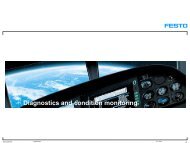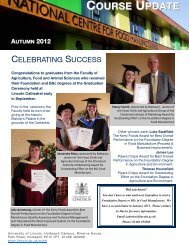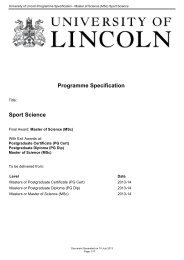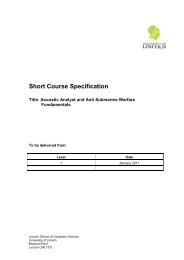Download Carbon Management Plan - University of Lincoln
Download Carbon Management Plan - University of Lincoln
Download Carbon Management Plan - University of Lincoln
Create successful ePaper yourself
Turn your PDF publications into a flip-book with our unique Google optimized e-Paper software.
<strong>Carbon</strong> <strong>Management</strong> <strong>Plan</strong>7. Actions to Embed <strong>Carbon</strong> <strong>Management</strong> in our Organisation 227.1 Policy 227.2 Responsibility 237.3 Data management 247.4 Communication and Training 247.5 Finance and Investment 267.6 Procurement 267.7 Monitoring and Evaluation 278. <strong>Management</strong> <strong>of</strong> <strong>Carbon</strong> Reduction Actions 288.1 Ongoing stakeholder management 288.2 Annual Progress review 29Appendix A: <strong>Carbon</strong> <strong>Management</strong> Embedding Matrix 30- 3 -
<strong>Carbon</strong> <strong>Management</strong> <strong>Plan</strong>Foreword from the Vice ChancellorAs Global Climate Change is one <strong>of</strong> the majorchallenges facing our planet I am pleased that the<strong>University</strong> <strong>of</strong> <strong>Lincoln</strong> is taking positive steps to reduceits emissions <strong>of</strong> greenhouse gases. The ambitiousprogramme described in this <strong>Carbon</strong> <strong>Management</strong> <strong>Plan</strong>sets out how the <strong>University</strong> can play its part in meetingnational and international targets for emissionsreduction.Our target to cut carbon dioxide emissions by 43% by2020 is challenging, but attainable. Reaching the targetwill mean that we will have to transform how weprocure, supply and use energy around the <strong>University</strong>.The programme outlined in this document will alsomean that the energy costs for our estate arecontrolled. We all have a part to play in this and I will beactively involved and I do hope everyone can embracethis agenda positively.As an organisation we can have a huge impact on emissions <strong>of</strong> carbon dioxide around<strong>Lincoln</strong>shire and beyond. By providing our students with knowledge on sustainabledevelopment within our courses we can embed sustainability within society. Additionally, ourcarbon dioxide reduction target sets an example to other organisations around the region toreduce their greenhouse emissions.Pr<strong>of</strong>. Mary StuartVice Chancellor, <strong>University</strong> <strong>of</strong> <strong>Lincoln</strong>- 4 -
<strong>Carbon</strong> <strong>Management</strong> <strong>Plan</strong>1. IntroductionThe <strong>University</strong> <strong>of</strong> <strong>Lincoln</strong> is a place <strong>of</strong> high ambition, an institution whose progress since it wascreated in 2001 has been rapid and solidly grounded. With over 10,000 students and 1,200staff based on five campuses across <strong>Lincoln</strong>shire, the <strong>University</strong> sees itself as a 21st centuryexpression <strong>of</strong> the old university ideal – where the student focus is paramount – at the sametime as fulfilling the modern tasks <strong>of</strong> knowledge creation and transfer for the economic, socialand cultural benefit <strong>of</strong> our society.The <strong>University</strong> <strong>of</strong> <strong>Lincoln</strong>, along with many Higher Education Institutions (HEIs), acknowledgesthat climate change is a real and growing threat for countries, economies, and organisations inthe public and private sector. By completing this <strong>Carbon</strong> <strong>Management</strong> <strong>Plan</strong>, the <strong>University</strong> istaking a strategic view <strong>of</strong> carbon emissions, and is contributing to HE sector and nationalcommitments to reduce emissions <strong>of</strong> CO 2 .This plan sets out the <strong>University</strong> <strong>of</strong> <strong>Lincoln</strong>’s vision for a lower carbon campus, assessingwhere we are now and what needs to be done over the next five years to ensure we are oncourse to meet the longer term 2020/21 carbon reduction targets. A key part <strong>of</strong> this plan issetting out how carbon management will be embedded into the day to day running <strong>of</strong> the<strong>University</strong>, supporting our wider corporate objectives and aspirations to become a Top 50institution.The <strong>University</strong> has received £100k from HEFCE and Salix Finance which, with an additionalcontribution from the university, has established a £125k Revolving Green Fund dedicated toinvestment in energy saving technologies.The Environmental Team has been expanded with the creation <strong>of</strong> the post <strong>of</strong> <strong>Carbon</strong>Reduction Manager, providing a dedicated resource to deliver this plan and embed carbonmanagement within all the <strong>University</strong>’s operations and activities.However, the most notable success to date is achieving an absolute reduction in our carbonemissions since 2005/06, despite expanding our campuses and increasing student numbers.This is a challenge that many other HEIs are struggling to meet and provides an excellentplatform for ongoing carbon reduction success.- 5 -
<strong>Carbon</strong> <strong>Management</strong> <strong>Plan</strong>2. <strong>Carbon</strong> <strong>Management</strong> StrategyRather than a stand-alone concern, carbon management is recognised by the <strong>University</strong> <strong>of</strong><strong>Lincoln</strong> as a whole-organisation approach which integrates with existing strategic aims andmanagement systems. This approach enables a clear view <strong>of</strong> the carbon impact <strong>of</strong> alluniversity operations and activities and allows key risks and opportunities to be identified andbuilt into a plan to reduce carbon emissions effectively.2.1 Context and drivers for <strong>Carbon</strong> <strong>Management</strong>The Global and National ContextRecognition that climate change is a reality and that change is required to both mitigate andadapt to its effects has increased substantially in recent years. Over the next 50 years thedaily effects <strong>of</strong> climate change, the availability and price <strong>of</strong> fossil fuels, environmentalregulation and new technologies will fundamentally change the supply and use <strong>of</strong> energy, andmake the emission <strong>of</strong> greenhouse gases one <strong>of</strong> society’s key concerns.In 2008 the UK became the first country to introduce a long-term legally binding frameworkspecifically aimed at tackling the dangers <strong>of</strong> climate change. The Climate Change Act putsinto statute the UK’s targets to reduce carbon dioxide emissions by at least 80% by 2050,against at 1990 baseline. It also requires five-year carbon budgets to be in place, monitoringand limiting annual carbon emissions.HE Sector DriversThe Higher Education sector is a significant user <strong>of</strong> energy, spending around £200M andemitting around 3.3mtCO 2 each year. The 2009 grant letter to HEFCE from the Governmentstates that the HE sector is expected to achieve a reduction in carbon dioxide emissions <strong>of</strong> atleast 34% by 2020, against 1990 levels. In addition the letter puts forward an 80 percentreduction by 2050, in line with the Climate Change Act.This was followed in 2010 by the HEFCE publication ‘<strong>Carbon</strong> reduction target and strategy forhigher education in England’. This restated the sector target against a 2005 baseline year andrequires all institutions to establish realistic carbon reduction plans, setting clear targets up to2020. As a clear financial driver, HEFCE have also linked capital funding to performancemonitored against these plans.Financial DriversThe <strong>University</strong>’s annual energy bill is around £2M. With gas and electricity prices linked to oil,price fluctuations <strong>of</strong> this valuable commodity cut right across the energy market. Continuingvolatility <strong>of</strong> these markets combined with ongoing depletion <strong>of</strong> the world’s oil stocks is likely toresult in the further increase in the unit cost <strong>of</strong> energy. This is particularly pertinent to theuniversity as its fixed-rate gas and electricity contracts finish at the end <strong>of</strong> 2010/11. A newflexible approach to energy procurement reduces the risk <strong>of</strong> extreme price shocks but energydemand minimization remains the most robust strategy for long term cost control.Legislative DriversThe <strong>University</strong> <strong>of</strong> <strong>Lincoln</strong>, like many HEIs, is also subject to increasing climate change-drivenregulation. The Energy Performance <strong>of</strong> Buildings Directive requires Energy Performance- 6 -
<strong>Carbon</strong> <strong>Management</strong> <strong>Plan</strong>Certificates (EPCs) and Display Energy Certificates (DECs) to be produced for a number <strong>of</strong>buildings. With this brings increasing costs <strong>of</strong> compliance and raises the reputational bar asbuilding energy performance is made more transparent and prominent.The <strong>Carbon</strong> Reduction Commitment (CRC) now also requires the <strong>University</strong> to monitor,assess and manage carbon emissions throughout the year. These have to be reportedannually to the Environment Agency and allowances have to be purchased for every tonne <strong>of</strong>CO 2 emitted. This provides a significant financial incentive for proactively reducing the<strong>University</strong>’s carbon emissions.Reputational DriversIn addition to the financial drivers the CRC creates to reduce carbon, the publically availableleague table <strong>of</strong> performance adds a crucially important reputational driver. Similar leaguestables, such as the annual Green League are becoming more established and environmentalperformance is being scrutinized more than ever before.Building on the good reputation established over the last ten years will be crucial for the<strong>University</strong> <strong>of</strong> <strong>Lincoln</strong> to achieve its strategic goal <strong>of</strong> becoming a Top 50 institution, and evenmore so following the announced changes in HE funding. It is therefore imperative that theuniversity does not lag behind its peers and competitors.<strong>University</strong> Alliance - <strong>Carbon</strong> Emissions per FTE Student & Staff Member in 2005/0620003,1023,87518001600<strong>Carbon</strong> Emissions (kg)1400120010008006004002000Sheffield HallamHuddersfieldWest <strong>of</strong> EnglandBournemouthNottingham TrentDe MontfortTeessideNorthumbriaLiverpool JohnMooresManchesterMetropolitanPortsmouthOxford Brookes<strong>Lincoln</strong>SalfordHertfordshireBradfordOpen <strong>University</strong>PlymouthFigure 1: Comparison <strong>of</strong> the carbon intensity <strong>of</strong> <strong>University</strong> Alliance member institutions.In comparison with the other English members <strong>of</strong> the <strong>University</strong> Alliance group <strong>of</strong> HEinstitutions the <strong>University</strong> <strong>of</strong> <strong>Lincoln</strong> has a relatively high level <strong>of</strong> carbon emissions per full timeequivalent (FTE) student and staff member. There are 18 members <strong>of</strong> the <strong>University</strong> Alliancein England and <strong>Lincoln</strong> has the fifth highest level <strong>of</strong> carbon emissions out <strong>of</strong> this group. Thehigh level <strong>of</strong> carbon emissions indicates that there is potential for significant reductions incarbon emissions.- 7 -
<strong>Carbon</strong> <strong>Management</strong> <strong>Plan</strong>2.4 Targets and objectivesIn line with the recommendations set out by HEFCE in their January 2010 document “<strong>Carbon</strong>reduction target and strategy for higher education in England”; the <strong>University</strong> <strong>of</strong> <strong>Lincoln</strong> hasset the following carbon reduction target:A reduction in annual carbon emissions <strong>of</strong> 43% by the end <strong>of</strong> the 2020/21academic year, compared to 2005/06 baseline emissions.Two interim targets have also been set:• A reduction in annual carbon emissions by 12% by 2012/13• A reduction in annual carbon emissions by 29% by 2017/18The <strong>University</strong> aspires to go beyond these targets and will assess possible further carbonsavings at each milestone target.All annual emissions are measured over the university academic year, running from 1 st Augustto 31 st July; refer to all scope 1 and 2 emissions (described in section 3.1); and will be statedin terms <strong>of</strong> tonnes <strong>of</strong> carbon dioxide equivalent (tCO 2 e).ObjectivesThe following supporting objectives have also been set:1. The <strong>University</strong> will raise awareness <strong>of</strong> carbon management at both strategic andoperational levels across the institution and will publish an annual report on carbonreduction progress to date.2. <strong>Carbon</strong> management will be embedded and aligned with all university policies andstrategies by 2020, with the Estates Strategy being the first to be reviewed in 2011.3. Regular analysis and dissemination <strong>of</strong> energy, carbon and cost data will be establishedin 2010/11.4. All existing infrastructure will be assessed for carbon reduction potential and carbonreduction considerations will be incorporated in all new build and major refurbishmentprojects.5. The Eco-Champions network will be expanded to cover all university departments andthe Students Union by 2012, establishing itself as core channel for carbon reductioncommunications.6. Internal and external funding for carbon reduction investment will be actively sort andconsidered by the <strong>University</strong>.7. A methodology for calculating indirect carbon emissions (scope 3) will be developed toenable inclusion in future carbon management reporting.- 9 -
<strong>Carbon</strong> <strong>Management</strong> <strong>Plan</strong>3. Emissions baseline and projectionsCalculating an emissions baseline is the first step in enabling the <strong>University</strong> to gain a betterunderstanding <strong>of</strong> its overall carbon contribution. This baseline ‘carbon footprint’ will becomethe comparison year to measure the <strong>University</strong>’s annual emissions going forwards, trackingprogress against the carbon reduction targets.This section outlines the emission sources that have been included and methodology appliedto calculate the baseline.3.1 ScopeThe Greenhouse Gas (GHG) Protocol defines direct and indirect emissions as follows:• Direct GHG emissions are emissions from sources that are owned or controlled bythe university.• Indirect GHG emissions are emissions that are a consequence <strong>of</strong> the activities <strong>of</strong> theuniversity, but occur at sources owned or controlled by another entity.These can be further categorized into three broad scopes:• Scope 1: All direct GHG emissions – e.g. gas, oil, LPG used on site• Scope 2: Indirect GHG emissions from consumption <strong>of</strong> purchased electricity, heat orsteam.• Scope 3: Other indirect emissions, such as transport-related activities in vehicles notowned or controlled by the university, outsourced activities, waste disposal, etc.The 2005/06 baseline calculations include Scope 1 and 2 emissions resultingfrom the activities <strong>of</strong> all <strong>University</strong> <strong>of</strong> <strong>Lincoln</strong> campuses.All comparison annual emissions will include Scope 1 and 2 emissions as a minimum. Inaddition (as stated in Objective 7 above), Scope 3 emissions will also be included as reliabledata becomes available.Emissions are expressed in terms <strong>of</strong> carbon dioxide equivalent (CO 2 e). This converts theglobal warming potential values <strong>of</strong> each GHG emission included in Scopes 1-3 into a singlecarbon dioxide measure.- 10 -
<strong>Carbon</strong> <strong>Management</strong> <strong>Plan</strong>Table 2 and figure 2 (below) detail how the university’s total baseline emissions are splitbetween the different fuel sources.Tonnes <strong>of</strong> <strong>Carbon</strong> Dioxide equivalent (tCO 2 e)Year Electricity GasHeatingOilLPGVehicleFuelAll Fuels2005/06 6,459 2,520 659 112 30 9,781Table 2: Breakdown <strong>of</strong> baseline emissions by fuel type2005/06 Baseline Emissions by Fuel Source (tCO2e)Heating Oil659(6.7%)LPG112(1.1%)Vehicle Fuel30(0.3%)Gas2,520(25.8%)Electricity6,45966.0%Figure 2: Breakdown <strong>of</strong> baseline emissions by fuel type- 12 -
<strong>Carbon</strong> <strong>Management</strong> <strong>Plan</strong>3.4 Progress to dateThe annual carbon emissions calculated in section 3.3 have been plotted against an evenlyweighted carbon reduction path for each interim target period in Figure 3 below:12,000Annual <strong>Carbon</strong> Emissions: 2005/06 - 2009/1010,000Annual Emissions by Fuel Type (tCO2e)8,0006,0004,0002,000Vehicle FuelLPGHeating OilGasElectricityTarget-2005/062006/072007/082008/092009/102010/112011/122012/132013/142014/152015/162016/172017/182018/192019/202020/21Academic YearFigure 3: Tracking annual emissions against target emission levels.This highlights the scale <strong>of</strong> the challenge set out in our carbon reduction targets. Whilst the<strong>University</strong> has successfully reduced its carbon emissions by 4.6% since 2005/06, 2009/10emissions were still higher than the target line above. The implication <strong>of</strong> this is that between2010/11 and 2012/13, year on year carbon reductions will have to be greater to ensure thatthe first milestone target is met. This has been considered throughout this plan andconsidered achievable.- 14 -
4. <strong>Carbon</strong> Reduction Projects<strong>Carbon</strong> <strong>Management</strong> <strong>Plan</strong>The tables below provide details <strong>of</strong> existing carbon reduction projects, projects that have already been planned and funding secured, projects expectedto take place in the near term but have not been allocated specific funding, plus some medium and longer term projects that are yet to be fully plannedbut are likely to take place.The tables are not an exhaustive list and will be updated as part <strong>of</strong> the annual review.4.1 Existing ProjectsRef Project LeadCostAnnual SavingsCapital Revenue Resource Financial <strong>Carbon</strong>PIR Controls for Science Building DC £ 8,154 £ - £ - £ 2,880 15.7 2.8 2009/10Desktop PC Energy Efficiency DC £ 16,701 £ 1,400 £ - £ 46,000 250.2 0.4 2009/10Rural Science Centre BMS DC £ 3,329 £ - £ - £ 1,260 3.7 2.6 2009/10Lighting Controls - MHT Building DC £ 2,806 £ - £ - £ 959 4.3 2.9 2010/11PaybackYear4.2 <strong>Plan</strong>ned / Funded ProjectsRef Project LeadCostAnnual SavingsPayResourcCapital RevenueFinancial <strong>Carbon</strong> backeYearBMS Bacnet System for Holbeach Campus DC £ 7,267 £ - £ - £ 2,294 9.4 3.2 2010/11Time Switches for Electrical Equipment DC £ 1,500 £ - £ - £ 672 3.1 2.2 2010/11GCW Library <strong>Plan</strong>t Room Insulation DC £ 910 £ - £ - £ 281 1.6 3.2 2010/11Eco Hand Dryers - Brayford Campus DC £ 11,497 £ - £ - £ 4,284 27.7 2.7 2010/11GCW Library - Lighting Controls DC £ 1,750 £ - £ - £ 460 2.1 3.8 2010/11Engine Shed Lighting Improvements DC £ 8,455 £ - £ - £ 2,618 11.9 3.2 2010/11Energy awareness campaign CT £ - £ 4,000 £ - £ 15,000 45.0 2010/11Development <strong>of</strong> Eco-Champions Network CT/ DC £ - £ - £ 2,000 £ 4,000 6.0 2010Developing building action plans CT £ - £ - £ 2,000 £ 7,000 8.0 2011- 15 -
<strong>Carbon</strong> <strong>Management</strong> <strong>Plan</strong>4.3 Near Term projectsRef Project LeadCostAnnual SavingsCapital Revenue Resource Financial <strong>Carbon</strong>PaybackYearPIR Controls Bridge House Stairs PL £ 2,500 £ - £ - £ 540 2.5 3 2011PIR lighting controls for MHT & MABcorridorsPL £ 5,500 £ - £ - £ 1,700 11.0 3.2 2011Boiler optimisation trial at Brayford Campus SC £ 4,000 £ - £ - £ 2,000 7.0 2 2011AMC Lighting improvements PL £ 8,000 £ - £ - £ 2,500 11.0 3.2 2011BMS control review CT £ - £ - £ 2,000 £ 8,000 10.0 0.25 2011Brayford Campus Street Lighting to LED PL £ 25,000 £ - £ - £ 8,000 15.0 3.1 2011/12Rolling LED Lighting Programme – start withLPACDC £100,000 £ - £ - £ 20,000 30.0 5 2012LTM <strong>Plan</strong> <strong>Plan</strong>t Upgrades GMc £4M £ - £ - £120,000 1,000.0 N/ACathedral Campus Consolidation GMc £7M £ - £ - £ 54,000 300.0 N/A 20152011-20204.4 Medium to Long Term ProjectsRef Project LeadCostAnnual SavingsCapital Revenue Resource Financial <strong>Carbon</strong>PaybackYearMoving ICT Servers <strong>of</strong>f site ICT £ - £ - £ - N/A 800 N/A 2013Voltage Optimisation at Riseholme PL £ 40,000 £ - £ - £ 8,000 48 5 2013Replacement <strong>of</strong> old building stock at Riseholme GMc £8M £ - £ - £100,000 120 N/A 2015CHP plant for Brayford Campus GMc £2M £ - £ - £400,000 3,000 5 2017Photovoltaic Panels DC £150,000 £ - £ - £ 20,000 20 N/A 2013- 16 -
<strong>Carbon</strong> <strong>Management</strong> <strong>Plan</strong>5. Implementation <strong>Plan</strong> financing5.1 Financial RisksThere is significant potential that the energy costs to the <strong>University</strong> could increase significantlyin the years up to 2020. This is particularly true for electricity costs. The European LargeCombustion <strong>Plan</strong>t Directive means that many <strong>of</strong> the coal fired power stations in the UK willneed to be replaced or adapted by 2015. In addition, many <strong>of</strong> the older nuclear power stationsare due to be decommissioned between 2011 and 2020. Therefore, significant investment willbe required in large scale electricity generating capacity. Much <strong>of</strong> this investment may beproduced by passing costs on to the consumer. Electricity prices <strong>of</strong> 15 pence per kilowatt-hourcould be expected by 2015, in comparison to current rates <strong>of</strong> circa. 9 p/kWh.In addition, a series <strong>of</strong> schemes introducing carbon pricing into the energy market are havinga financial impact on the <strong>University</strong>. The <strong>University</strong> already incurs a significant cost throughlegislative schemes aimed at tackling climate change. All <strong>of</strong> our electricity and gas bills includethe Climate Change Levy (CCL). In the 2009/10 financial year the CCL costs to the <strong>University</strong>amounted to £48.8k for electricity and £22.7k for gas.From April 2011 the <strong>University</strong> will incur the additional cost <strong>of</strong> complying with the <strong>Carbon</strong>Reduction Commitment (CRC). This places a charge <strong>of</strong> £12 per on each tonne <strong>of</strong> carbon thatparticipants generate. The expected cost to the <strong>University</strong> <strong>of</strong> the CRC is around £112,000 perannum.The current plan is that after the first two years <strong>of</strong> the CRC the cost <strong>of</strong> carbon allowances willfloat on an open market. Therefore, the price <strong>of</strong> each tonne <strong>of</strong> carbon could increasesignificantly above £12. At £30 per tonne (a price reached on the European <strong>Carbon</strong> Market)the cost to the <strong>University</strong> would be around £280k per annum.For every tonne <strong>of</strong> carbon dioxide that the <strong>University</strong> can reduce from its emissions baselinethe overall financial risk is reduced. By cutting carbon the <strong>University</strong> will cut utilities costs, cutCRC costs and move towards meeting HEFCE carbon reduction targets.5. 2 Funding the <strong>Carbon</strong> <strong>Management</strong> <strong>Plan</strong>Revolving Green FundIn 2009 the <strong>University</strong> received £100k from the HEFCE Revolving Green Fund, which is a jointinitiative between HEFCE and Salix Finance. Under the scheme the funding can be used toimplement energy saving projects provided that they meet a set <strong>of</strong> criteria covering paybackperiods and lifetime carbon savings.The Revolving Green Fund is provided as an interest free loan on condition that savings fromthe projects are reinvested in more energy saving initiatives. Provided that compliant projectscan be identified the loan does not have to be repaid.In the years up to 2015 the Revolving Green Fund will be a key element <strong>of</strong> the funding <strong>of</strong> the<strong>Carbon</strong> <strong>Management</strong> <strong>Plan</strong>. It will be used to fund projects such as plant room insulation,- 17 -
<strong>Carbon</strong> <strong>Management</strong> <strong>Plan</strong>automatic lighting and boiler optimisation. Increasingly the Fund will be used to implementLED lighting projects as the technology becomes more developed.In addition, Salix Finance regularly has funding streams for one <strong>of</strong>f interest free loans forenergy efficiency projects.Long Term Maintenance FundingIn 2008 a report was produced for the <strong>University</strong> by White Young Green on long termmaintenance around the Estate. This report identified a number <strong>of</strong> projects where major items<strong>of</strong> plant such as boilers and chillers would need replacing. Under the LTM <strong>Plan</strong> the projectswere prioritised and will be tackled over each summer break.Already the chiller units and boilers have been replaced in the Main Administration Buildingand the Media Humanities and Technology Building. By replacing old inefficient equipmentwith the latest kit it has been possible to produce significant energy savings.In future years the LTM Fund can make a significant contribution to the reduction <strong>of</strong> carbonemissions. The opportunity to cut carbon emissions needs to be a key consideration in everyproject that is undertaken through the LTM <strong>Plan</strong>.Invest to SaveThe <strong>University</strong> has some money available for ‘Invest to Save’ projects where clear savingsand payback times can be demonstrated. Potentially energy saving projects could besubmitted to this fund, although it has relatively similar criteria to the Salix Fund.Energy Services ContractsESCOs <strong>of</strong>fer a major potential to implement energy saving projects without the need for directcapital investment from the <strong>University</strong>. Under an ESCO the <strong>University</strong> would sign anagreement with an energy services company for a specific energy project. The project couldbe for a major investment such as a Combined Heat and Power facility – the ESCO wouldbuild, operate and maintain the facility and the <strong>University</strong> would sign a long term contract topurchase heat and power from the CHP.ESCOs can also be undertaken for renewable energy projects and major plant refurbishmentschemes. ESCOs can take many different forms, but <strong>of</strong>ten the agreement would be for theESCO to operate and manage a facility. Performance and operating guarantees would be builtinto the contract. These guarantees are likely to be similar to those expected in any operationand maintenance contract. Energy savings and reductions <strong>of</strong> CO 2 emissions will notnecessarily be guaranteed, but the expectations <strong>of</strong> the parties to the arrangements will be thatthey will be reduced because <strong>of</strong> the type <strong>of</strong> plant being operated and maintained by theprivate sector ESCO. In some examples the ESCO agreement does include agreed energysavings within the contract.- 18 -
<strong>Carbon</strong> <strong>Management</strong> <strong>Plan</strong>6. Managing indirect emissionsOtherwise known as Scope 3 emissions, indirect emissions are those that result as aconsequence <strong>of</strong> the activities <strong>of</strong> the <strong>University</strong> but occur from sources not owned or controlledby the <strong>University</strong>. Whilst these indirect emissions are not included in the 43% carbon reductiontarget, the university has set on objective to measure and reduce these emissions (seesection 2.4).This section splits indirect emissions into five broad groups. For each emission source anoverview <strong>of</strong> current data availability and planned actions to improve measurement andreduction <strong>of</strong> emissions are outlined. As these are developed, additional scope 3 reductiontargets will be set in subsequent <strong>Carbon</strong> <strong>Management</strong> <strong>Plan</strong> reviews.6.1 Externally managed buildingsThe 17 student accommodation buildings at the Brayford Campus were transferred to amanagement company in 2005. As the buildings are not directly controlled and managed bythe <strong>University</strong> their carbon dioxide emissions have not been included within the baselinecalculation.The carbon emissions from the student accommodation are classed as scope threeemissions. In 2009/10 the buildings generated 612 tonnes <strong>of</strong> carbon dioxide from electricityusage and 891 tonnes from gas consumption. These emission will be continue to bemonitored and reported on as indirect emissions and ongoing work with the managementcompany to help reduce these will be pursued.6.2 Waste<strong>Carbon</strong> emissions result from the production, transportation and disposal <strong>of</strong> waste products.The ‘2010 Guidelines to Defra / DECC's GHG Conversion Factors for Company Reporting’provides a ‘Life-Cycle Factors for Waste Disposal’ conversion which can be used to estimatethe sum <strong>of</strong> these emissions (Figure 4 below).Figure 4: Life-Cycle Factors for Waste Disposal- 19 -
<strong>Carbon</strong> <strong>Management</strong> <strong>Plan</strong>At present the waste management company that collects waste from the <strong>University</strong> is not ableto provide details <strong>of</strong> the weight <strong>of</strong> waste collected. However, estimated figures have beenobtained by using the volume <strong>of</strong> the bin, the density <strong>of</strong> the material and the number <strong>of</strong>collections.Using this information, a calculation <strong>of</strong> the carbon emissions for all waste recycled and sent tolandfill in 2009/10 has been made (Table 4 below).Emission Source<strong>Carbon</strong> Emissions (tCO2e)Paper & cardboard 48.5Dense plastic 1.1Plastic film 0.7Ferrous metals 5.4Non-ferrous metals -25.9Glass 3.5Waste sent to landfill 1,988Total 2,021Table 4: 2009/10 indirect carbon emissions from recycled and landfill waste.Note that the figured for non-ferrous metal recycling gives a negative carbon dioxide emissions figure.This is because using waste aluminium products in smelting uses vastly less energy than smeltingaluminium from raw materials.With 2009/10 Scope 1 and 2 emissions totalling 9,335 tCO2e, this calculation demonstratesthat the indirect emissions generated by waste produced by the university are significant. Byproactively minimizing waste generation and increasing recycling rates, the university willtherefore benefit both financially and reduce its direct and indirect environmental impact.The <strong>University</strong> will work with its current waste contractor to improve data availability anddevelop internal processes to analyse and report this information regularly. Updated carbonemissions will also be calculated in subsequent reviews <strong>of</strong> the <strong>Carbon</strong> <strong>Management</strong> <strong>Plan</strong>.6.3 Water<strong>Carbon</strong> emissions result from the supply and treatment <strong>of</strong> water, and the industry’s buildingsand transport. The ‘2010 Guidelines to Defra / DECC's GHG Conversion Factors for CompanyReporting’ provides ‘Life-Cycle Conversion Factors for Water’ which, like waste, can be usedto estimate indirect carbon emissions resulting from the university’s water consumption.As all university water consumption is metered, data quality for the amount consumed is verygood. Since 2005/06, the university has reduced its water consumption. For the latestacademic year, 2009/10, the <strong>University</strong> used 39,070 m3 <strong>of</strong> water. Table 5 shows the indirectcarbon emissions resulting from the university’s water use in 2009/10.- 20 -
<strong>Carbon</strong> <strong>Management</strong> <strong>Plan</strong>Emission Source<strong>Carbon</strong> Emissions (tCO2e)Water Supply 11.5Waste-water treatment 28.9Total 40.4Table 5: 2009/10 indirect carbon emissions from water consumption.Emission figures from water consumption will continue to be calculated and reported on forsubsequent years, and targets may later be set.The university will also continue to actively manage its water consumption, driven bothfinancially and from its wider environmental concern to conserve this limited natural resource.However, within the scope <strong>of</strong> the carbon management plan, there is unlikely to be a strongemphasis on reducing water use as even substantial volume savings will make a relativelysmall contribution to reducing the university’s overall carbon footprint.6.4 Travel<strong>Carbon</strong> emissions that result from travel for university activities can be split into three broadcategories:• Staff and student business travel;• Staff and student commuting; and• Student travel between home and the universityIn addition, the different modes <strong>of</strong> transport used (car, train, bus, aeroplane etc) areresponsible for different levels <strong>of</strong> carbon emissions. Collecting data for all <strong>of</strong> these categoriesand modes <strong>of</strong> transport is therefore a complex process.The ‘2010 Guidelines to Defra / DECC's GHG Conversion Factors for Company Reporting’provides a range <strong>of</strong> conversion factors that can be applied to quantities <strong>of</strong> fuel used ordistances travelled by a range <strong>of</strong> different modes <strong>of</strong> transport, enabling the carbon emissionsfrom these activities to be calculated. However, at present the <strong>University</strong> does not collate datain a form that could be used to calculate these emissions.To enable these emissions to be reported in future, the university will review the current dataavailable and develop a plan to address any data gaps. Progress will continue to be reportedin all subsequent reviews <strong>of</strong> the <strong>Carbon</strong> <strong>Management</strong> <strong>Plan</strong>.6.5 ProcurementAt present, the university has not attempted to calculate its indirect carbon emissions as aresult <strong>of</strong> its procurement activities. The ‘2010 Guidelines to Defra / DECC's GHG ConversionFactors for Company Reporting’ does provide a template for estimating these. Before the nextreview, work will be undertaken to identify how these emissions can be estimated goingforwards.- 21 -
<strong>Carbon</strong> <strong>Management</strong> <strong>Plan</strong>7. Actions to Embed <strong>Carbon</strong> <strong>Management</strong> in the OrganisationThis <strong>Carbon</strong> <strong>Management</strong> <strong>Plan</strong> sets out the <strong>University</strong> <strong>of</strong> <strong>Lincoln</strong>’s low carbon vision, itscarbon reduction targets and its plan to achieve these. It has been endorsed by the Vice-Chancellor and is available publically, demonstrating the institution’s commitment toembedding carbon management.Appendix A shows the <strong>Carbon</strong> <strong>Management</strong> Embedding Matrix which consists <strong>of</strong> sevensubject headings with embedding actions for each subject that are ranked in five levels fromworst to best practice.An assessment has been made <strong>of</strong> the <strong>University</strong>’s perceived current score for each categoryand the scores expected to be achieved by the 2012/13 and 2017/18 interim target dates.These are summarised in Table 6 below and discussed further in sections 7.1 to 7.6.Area <strong>of</strong> WorkCurrent Score(5=best, 1=worst)Expected Scoreby 2012/13Expected Scoreby 2017/18Policy 3 5 5Responsibility 3 4 5Data <strong>Management</strong> 3 4 5Communication & Training 2 4 5Finance & Investment 3 5 5Procurement 2 4 5Monitoring & Evaluation 2 4 5Table 6: <strong>Carbon</strong> <strong>Management</strong> Matrix Assessment Summary7.1 PolicyIn 2009 the <strong>University</strong> <strong>of</strong> <strong>Lincoln</strong> established an Environmental Policy and an Energy Policy.These set a commitment to ‘establish a culture where environmental performance iscontinually improved’, outlining specific areas <strong>of</strong> focus including the prevention <strong>of</strong> pollution,reducing energy consumption, sustainable procurement and additional Scope 3 carbonemission sources. Additionally, the Energy Policy states that the <strong>University</strong> will measurecarbon dioxide emissions and set targets for their reduction. These policies are due to bereviewed in 2010/11 and any amendments will be approved by the <strong>University</strong>’s InfrastructureCommittee (chaired by the Vice-Chancellor).Policy reviews will subsequently be aligned with annual reporting on progress against the<strong>Carbon</strong> <strong>Management</strong> <strong>Plan</strong> and will follow guidance specified in best practice standardsISO14001 Environmental <strong>Management</strong> System and BS EN 160001 Energy <strong>Management</strong>System, enabling the <strong>University</strong> to score 5 in the policy section <strong>of</strong> the embedding matrix by theend <strong>of</strong> 2012/13.Additional policies will also be developed to support the wider Environmental Policy related toareas including sustainable procurement, whole life costing and business travel.- 22 -
Policy Performance Criteria & Assessment Summary<strong>Carbon</strong> <strong>Management</strong> <strong>Plan</strong>5Best• SMART Targets signed <strong>of</strong>f• Action plan contains clear goals & regular progress reviews• Strategy launched internally & to communityBy 2012/134 • SMART Targets developed but not implemented321Worst• Draft policy• Climate Change reference• No policy• Climate Change aspiration• No policy• No Climate Change referenceCurrentPosition7.2 ResponsibilityStrategic carbon management is the responsibility <strong>of</strong> the Director <strong>of</strong> Estates and CommercialFacilities. Day-to-day operational carbon management responsibility lies with the <strong>Carbon</strong>Reduction Manager (a full-time post created in September 2010). A growing network <strong>of</strong> Eco-Champions is also being established, integrating carbon management across all academicand service departments within the <strong>University</strong> and is supported by the Vice-Chancellor.Responsibility Performance Criteria & Assessment Summary5Best4321Worst• CM is full-time responsibility <strong>of</strong> a few people• CM integrated in responsibilities <strong>of</strong> senior managers• VC support• Part <strong>of</strong> all job descriptions• CM is full-time responsibility <strong>of</strong> an individual• CM integrated in to responsibilities <strong>of</strong> departmentmanagers, not all staff• CM is part-time responsibility <strong>of</strong> a few people• CM responsibility <strong>of</strong> department champions• CM is part-time responsibility <strong>of</strong> an individual• No departmental champions• No CM responsibility designationBy 2017/18By 2012/13CurrentPositionIncreasing focus will be placed on devolving carbon management responsibility todepartmental managers and topic-specific working groups (such as ICT and Space <strong>Plan</strong>ning &Timetabling). These actions will enable the <strong>University</strong> to meet the level 4 embeddingrequirements, and provide a firm foundation for the additional formal devolving <strong>of</strong> responsibilityneeded to meet level 5 by 2017/18.- 23 -
<strong>Carbon</strong> <strong>Management</strong> <strong>Plan</strong>7.3 Data <strong>Management</strong>The <strong>University</strong> currently has substantial building-level sub metering across the BrayfordCampus for gas, water and electricity. The majority <strong>of</strong> electricity consumed on other campusesis provided on a half-hourly contract allowing visibility <strong>of</strong> consumption pr<strong>of</strong>ile for discretegroups <strong>of</strong> buildings. Itemised vehicle fuel deliveries are provided by suppliers for ownedvehicle emissions but considerable work is required to capture data for other transportemissions. This will be incorporated by 2012/13 along with waste and water emissions dataenabling an increase to level 4 <strong>of</strong> the embedding matrix.Data <strong>Management</strong> Performance Criteria & Assessment Summary5Best4321Worst• Quarterly collation <strong>of</strong> CO 2 emissions for all sources• Data externally verified• M&T in place for:o Buildingso Waste• Annual collation <strong>of</strong> CO 2 emissions for:• Buildings• Transport• Waste• Data internally reviewed• Collation <strong>of</strong> CO 2 emissions for limited scope i.e. buildingsonly• No CO 2 emissions data compiled• Energy data compiled on a regular basis• Not compiled:o CO 2 emissionso Estimated billingBy 2017/18By 2012/13CurrentPositionBuilding-level monitoring and targeting will also be in place for the Brayford Campus by2012/13 (Objective 3). The <strong>University</strong> has invested in eSight energy management s<strong>of</strong>twareand ongoing work to maximise its utilisation continues. This will enable monthly carbonemissions calculations by <strong>Carbon</strong> Reduction Manager, which will be disseminated to theInfrastructure Committee on a regular basis. However, the <strong>University</strong> does not expect theachieve level 5 on the embedding matrix by 2012/13 as there are no current plans to meet theadditional cost <strong>of</strong> having the data externally verified.Making energy, cost and carbon emissions data available to staff and students on a regularbasis is a key strategic theme <strong>of</strong> this plan. During 2010/11 work will be undertaken to consultwith senior managers, staff and students to identify how best to disseminate the information.7.4 Communication and TrainingThe <strong>University</strong>’s low carbon vision to be an institution that ‘proactively engages with staff andstudents to establish a campus culture where low carbon choices become the standard’- 24 -
<strong>Carbon</strong> <strong>Management</strong> <strong>Plan</strong>highlights the importance placed on embedding low carbon communications and training intoall our operation and activities.Communication and Training Performance Criteria & Assessment Summary5Best4321Worst• All staff & students given formalised CM:o Inductiono Training <strong>Plan</strong>o Communications• CM matters regularly communicated to:o External communityo Key partners• All staff & students given CM:o Inductiono Communications• CM communicated to:o External communityo Key partners• Environmental / energy group(s) give ad hoc:o Trainingo Communications• Regular poster/awareness campaigns• Staff & students given ad hoc CM:o Communications• No communication or trainingBy 2017/18By 2012/13CurrentPositionTo date there have been various environmental awareness activities that have run across thecampus. These include posters, establishing the Eco-Champion role, an environmentalsection in all staff inductions, and features in the staff magazine and daily email alerts. Theseactivities provide a strong platform to increase current performance in the embedding matrixfrom level 2 to level 4 by 2012/13.<strong>Plan</strong>ned activities include:• Extending the Eco-Champion network to cover all departments and establish regularmeetings and communication channels to share carbon reduction idea, activities, andprovide feedback.• Developing specific carbon reduction plans for the biggest energy users, starting withMain Admin, MHT, Science and Architecture buildings. These will be developed inconsultation with the relevant Eco-Champions, staff and students in each building.• In 2010/11, the Environment Team will launch a dedicated website which will include aspecific section on carbon reduction. Additional forms <strong>of</strong> social media will also be used,including blogs and twitter.- 25 -
<strong>Carbon</strong> <strong>Management</strong> <strong>Plan</strong>• A regular feature on carbon reduction will go in the Staff Magazine and further jointworking with the Marketing and Communications Team to promote carbon reductionactivities both internally and externally.7.5 Finance and InvestmentThis factor <strong>of</strong> embedding <strong>Carbon</strong> <strong>Management</strong> is covered in section five <strong>of</strong> this <strong>Plan</strong>. By2012/13 the <strong>University</strong> should achieve level 5.Finance and Investment Performance Criteria & Assessment Summary5Best4321Worst• Granular & effective financing mechanisms for CM projects• Finance representation on CM Team• Robust task management mechanismo Ring-fenced fund for carbon reduction initiatives• Regular financing for CM projects• Some external financingo Sufficient task management mechanism• Ad hoc financing for CM projects• Limited task managemento No allocated resource• Ad hoc financing for CM related projects• Limited task coordination resources• No internal financing or funding for CM related projectsBy 2012/13CurrentPosition7.6 ProcurementProcurement Performance Criteria & Assessment Summary5Best4321Worst• Senior purchasers consult & adhere to ICLEI’s Procura+manual & principles• Sustainability comprehensively integrated in tenderingcriteria• Whole life costingo Area-wide procurement• Environmental demands incorporated in tendering• Familiarity with Procura+o Joint procuring between HEIs or with LAs.• Whole life costing occasionally employedo Some pooling <strong>of</strong> environmental expertise• Green criteria occasionally considered• Products considered in isolation• No Green consideration• No life cycle costingBy 2017/18By 2012/13CurrentPosition- 26 -
<strong>Carbon</strong> <strong>Management</strong> <strong>Plan</strong>At present carbon reduction principles are not systematically included as part <strong>of</strong> the standardprocurement process. However, a common set <strong>of</strong> supply chain principles that require allsuppliers tendering for work to meet minimum environmental criteria is in place. In addition,some departments consider life costing, particularly for electrical equipment purchases.With procurement being responsible for a substantial part <strong>of</strong> the university’s indirect carbonemissions (see section 6.5), further joint-working with the central procurement team willcontinue, identifying the most appropriate way forward for the <strong>University</strong> <strong>of</strong> <strong>Lincoln</strong>.7.7 Monitoring & EvaluationWhilst efforts to review carbon management have been made to date, these have not beensystematic. A clear outcome <strong>of</strong> this plan will be to embed this into the regular duties <strong>of</strong> the<strong>Carbon</strong> Reduction Manager, utilising the eSight s<strong>of</strong>tware to automatically collect and analyseenergy data from the building sub-meters.Monitoring & Evaluation Performance Criteria & Assessment Summary5Best43• Senior management review CM process• Core team regularly reviews CM progress• Published externally on website• Visible board level review• Core team regularly reviews CM progress:o Actionso Pr<strong>of</strong>ile & Targetso New opportunities quantification• CM team review aspects including:o Policies / Strategieso Targetso Action <strong>Plan</strong>sBy 2017/18By 2012/132 • Ad hoc reviews <strong>of</strong> CM actions progress1Worst• No CM monitoringCurrentPositionCollection <strong>of</strong> additional data (such as occupancy hours and degree-days) will also be pursuedto aid more sophisticated analysis <strong>of</strong> building energy consumption and to set realistic buildingleveltargets.- 27 -
<strong>Carbon</strong> <strong>Management</strong> <strong>Plan</strong>8. <strong>Management</strong> <strong>of</strong> <strong>Carbon</strong> Reduction ActionsTo ensure that all the actions identified in this document are implemented as planned, ongoingmanagement <strong>of</strong> the carbon reduction process is vital. This section identifies the keystakeholders involved in this process and sets out how this document will be used andreported on going forwards.8.1 Ongoing stakeholder managementStakeholders are those parties either within or external to the <strong>University</strong> who will be affectedby the programme to reduce carbon emissions and may influence its success. The keystakeholders have been identified in Table 7 below:Stakeholder Influence Key issues/concerns Communication ChannelsGoverning Body High Strategic supportVC & ExecutiveBoardDeans andHeads <strong>of</strong>DepartmentsFinanceEstatesStaffStudentsLocal Authorities& AgenciesContractors &SuppliersHighHighHighHighHighMediumMediumMediumBudgets & fundingFuture strategic goalsReputation/pr<strong>of</strong>ile <strong>of</strong>universityBudgetsStaff numbersSpace utilisationFinancial planningProcurement & contractsLife-cycle costingEstates StrategyMaintenance & facilitiescostsCapital costsNew builds / refurbishmentsSpace <strong>Management</strong>Utility budgetComfortable workingconditionsCost & ease <strong>of</strong> travelJob security<strong>University</strong>’s customerExpectations <strong>of</strong> facilities andservicesGrowing environmentalawarenessLocal Area AgreementFunding to <strong>University</strong>Retain contractAdded costs burdenCommitteesAnnual reportExecutive Board MeetingsInfrastructure CommitteeAnnual and interim reportsManagers briefing updatesBuilding management plansDepartmental communicationsDepartmental communicationsBuilding Action <strong>Plan</strong>sDepartment communicationsEco-Champions networkDepartmental meetingsWebsiteDepartmental communicationsStudents Union/ societiesAcademic and researchprojectsHalls management company.Student communications.MeetingsContract tendersMeetingsMedia & Press Low Corporate image Press releasesCommunityLowTravel congestionCorporate imagePress releasesCommunity groupsTable 7: Key carbon management plan stakeholders.- 28 -
<strong>Carbon</strong> <strong>Management</strong> <strong>Plan</strong>8.2 Annual Progress reviewEach year a formal annual review <strong>of</strong> carbon reduction progress against this document will beundertaken. The first review will take place in October 2011, with each subsequent reviewundertaken annually from that date.The review will consider all the costs and benefits resulting from the carbon reduction activitiesoutlined in this plan. These will assess:• Financial savings, either cashable or returned to the ‘rotating fund’• <strong>Carbon</strong> savings against target• Less-quantifiable benefits, such as influencing the staff and student body, and localcommunityLed by the <strong>Carbon</strong> Reduction Manager and in consultation with key stakeholders, this reviewwill be submitted by the Director <strong>of</strong> Estates and Commercial Facilities to the InfrastructureCommittee (chaired by the Vice-Chancellor) and made publically available via the <strong>University</strong> <strong>of</strong><strong>Lincoln</strong> website and supporting communications.- 29 -
<strong>Carbon</strong> <strong>Management</strong> <strong>Plan</strong>Appendix A - <strong>Carbon</strong> <strong>Management</strong> Embedding MatrixPOLICYRESPONSIBILITYDATAMANAGEMENTCOMMUNICATION &TRAININGFINANCE &INVESTMENTPROCUREMENTMONITORING &EVALUATION5BEST• SMART Targetssigned <strong>of</strong>f• Action plancontains cleargoals & regularprogress reviews• Strategy launchedinternally & tocommunity• CM is full-timeresponsibility <strong>of</strong> a fewpeople• CM integrated inresponsibilities <strong>of</strong> seniormanagers• VC support• Part <strong>of</strong> all jobdescriptions• Quarterly collation <strong>of</strong>CO 2 emissions for allsources• Data externallyverified• M&T in place for:o Buildingso Waste• All staff & students givenformalised CM:o Inductiono Training <strong>Plan</strong>o Communications• CM matters regularlycommunicated to:o External communityo Key partners• Granular & effectivefinancing mechanismsfor CM projects• Finance representationon CM Team• Robust taskmanagement mechanism• Ring-fenced fund forcarbon reductioninitiatives• Senior purchasersconsult & adhere toICLEI’s Procura+manual & principles• Sustainabilitycomprehensivelyintegrated in tenderingcriteria• Whole life costing• Area-wide procurement• Senior managementreview CM process• Core team regularlyreviews CM progress• Published externallyon website• Visible board levelreview4• SMART Targetsdeveloped butnot implemented• CM is full-timeresponsibility <strong>of</strong> anindividual• CM integrated in toresponsibilities <strong>of</strong>department managers,not all staff• Annual collation <strong>of</strong> CO 2emissions for:oooBuildingsTransportwaste• Data internallyreviewed• All staff & students givenCM:ooInductionCommunications• CM communicated to:ooExternal communityKey partners• Regular financing for CMprojects• Some external financing• Sufficient taskmanagement mechanism• Environmental demandsincorporated in tendering• Familiarity withProcura+• Joint procuringbetween HEIs or withLAs.• Core team regularlyreviews CM progress:o Actionso Pr<strong>of</strong>ile &Targetso New opportunitiesquantification3• Draft policy• Climate Changereference• CM is part-timeresponsibility <strong>of</strong> a fewpeople• CM responsibility <strong>of</strong>department champions• Collation <strong>of</strong> CO 2emissions for limitedscope i.e. buildings only• Environmental / energygroup(s) give ad hoc:ooTrainingCommunications• Ad hoc financing for CMprojects• Limited taskmanagement• No allocated resource• Whole life costingoccasionally employed• Some pooling <strong>of</strong>environmental expertise• CM team reviewaspects including:o Policies /Strategieso Targetso Action <strong>Plan</strong>s2• No policy• Climate Changeaspiration• CM is part-timeresponsibility <strong>of</strong> anindividual• No departmentalchampions• No CO 2emissions datacompiled• Energy datacompiled on aregular basis• Regular poster/awarenesscampaigns• Staff & students given adhoc CM:oCommunications• Ad hoc financing for CMrelated projects• Limited task coordinationresources• Green criteriaoccasionally considered• Products considered inisolation• Ad hoc reviews <strong>of</strong> CMactions progress1Worst• No policy• No ClimateChange reference• No CM responsibilitydesignation• Not compiled:oCO 2 emissions• Estimated billing• No communication ortraining- 30 -• No internal financing orfunding for CM relatedprojects• No Green consideration• No life cycle costing• No CM monitoring
















